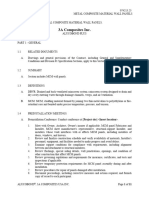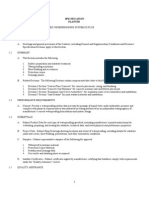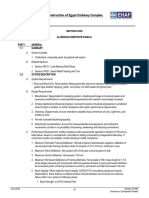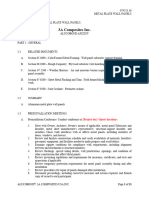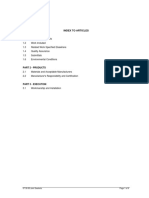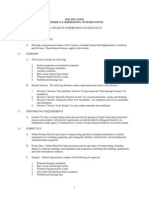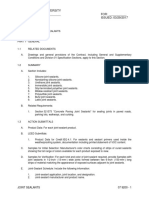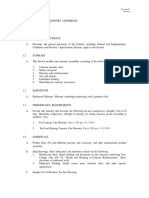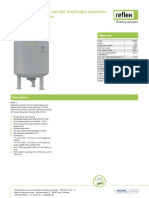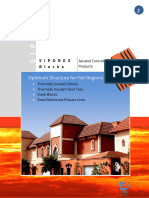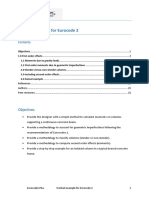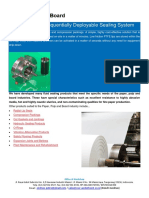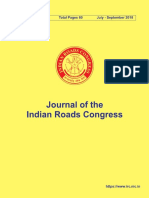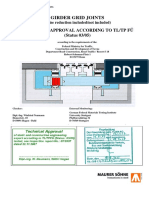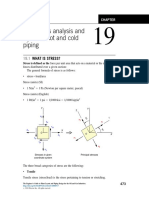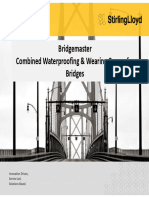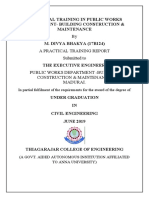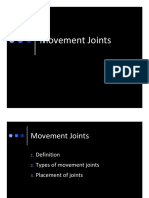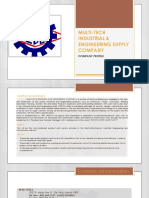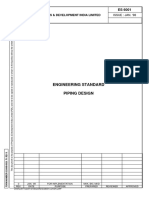Section 07920 Joint Sealants
Section 07920 Joint Sealants
Uploaded by
jcunha4740Copyright:
Available Formats
Section 07920 Joint Sealants
Section 07920 Joint Sealants
Uploaded by
jcunha4740Original Description:
Original Title
Copyright
Available Formats
Share this document
Did you find this document useful?
Is this content inappropriate?
Copyright:
Available Formats
Section 07920 Joint Sealants
Section 07920 Joint Sealants
Uploaded by
jcunha4740Copyright:
Available Formats
Taylor County July 2011
SECTION 07920 – JOINT SEALANTS
PART 1 - GENERAL
1.1 RELATED DOCUMENTS
A. Drawings and general provisions of the Contract, including General and Supplementary
Conditions and Division 1 Specification Sections, apply to this Section.
1.2 SUMMARY
A. This Section includes sealants for the following applications:
1. Exterior joints In the following vertical surfaces and nontraffic horizontal surfaces:
a. Control and expansion joints in cast-in-place concrete.
b. Joints between architectural precast concrete units.
c. Control and expansion joints in unit masonry.
d. Joints between different materials listed above.
e. Perimeter joints between materials listed above and frames of doors and windows.
f. Control and expansion joints in ceiling and overhead surfaces.
g. Other joints as indicated.
2. Exterior joints in the following horizontal traffic surfaces:
a. Control, expansion, and isolation joints in cast-in-place concrete slabs.
b. Joints between cast in place concrete and precast architectural concrete.
c. Other joints as indicated.
3. Interior joints in the following vertical surfaces and horizontal nontraffic surfaces:
a. Perimeter joints of exterior openings where indicated.
b. Perimeter joints between interior wall surfaces and frames of interior doors,
windows, and elevator entrances.
c. Joints between plumbing fixtures and adjoining walls, floors, and counters.
d. Other joints as indicated.
JOINT SEALANTS 07920 - 1
Taylor County July 2011
B. Related Sections include the following:
1. Division 7 Section “Firestopping” for fire-resistant building joint-sealant systems.
2. Division 8 Section “Glazing” for glazing sealants.
3. Division 9 Section “Gypsum Board Assemblies” for sealing perimeter joints of gypsum
board partitions to reduce sound transmission.
1.3 PERFORMANCE REQUIREMENTS
A. Provide elastomeric joint sealants that establish and maintain watertight and airtight continuous
joint seals without staining or deteriorating joint substrates.
1.4 SUBMITTALS
A. Product Data: For each joint-sealant product indicated.
B. Samples for Initial Selection: Manufacturer’s color charts consisting of strips of cured sealants
showing the full range of colors available for each product exposed to view.
C. Product Certificates: Signed by manufacturer’s color charts consisting of strips of cured
sealants showing the full range of colors available for each product exposed to view.
D. Compatibility and Adhesion Test Reports: From sealant manufacturer indicating the following:
1. Materials forming joint substrates and joint-sealant backings have been tested for
compatibility and adhesion with joint sealants.
2. Interpretation of test results and written recommendations for primers and substrate
preparation needed for adhesive.
E. Warranties: Special warranties specified in this Section.
1.5 QUALITY ASSURANCE
A. Installer Qualifications: An experienced installer who has specialized in installing joint sealants
similar in material, design, and extent to those indicated for this Project and whose work has
resulted in joint-sealant installations with a record of successful in-service performance.
B. Source Limitations: Obtain each type of joint sealant through one source form a single
manufacturer.
1.6 DELIVERY, STORAGE, AND HANDLING
A. Deliver materials to Project site in original unopened containers or bundles with labels
indicating manufacturer, product name and designation, color, expiration date, pot life, curing
time, and mixing instructions for multicomponent materials.
JOINT SEALANTS 07920 - 2
Taylor County July 2011
B. Store and handle materials in compliance with manufacturer’s written instructions to prevent
their deterioration or damage due to moisture, high or low temperatures, contaminants, or other
causes.
1.7 PROJECT CONDITIONS
A. Environmental Limitations: Do not proceed with installation of joint sealants under the
following conditions:
1. When ambient and substrate temperature conditions are outside limits permitted by joint
sealant manufacturer or are below 40 deg F.
2. When joint substrates are wet.
B. Joint-Width Conditions: Do not proceed with installation of joint sealants where joint widths
are less than those allowed by joint sealant manufacturer for applications indicated.
C. Joint-Substrate Conditions: Do not proceed with installation of joint sealants until contaminants
capable of interfering with adhesion are removed from joint substrates.
1.8 WARRANTY
A. General Warranty: Special warranties specified in this Article shall not deprive Owner of other
rights Owner may have under the provisions of the Contract Documents and shall be in addition
to, and run concurrent with, other warranties made by Contractor under requirements of the
Contract Documents.
B. Special Installer’s Warranty: Written warranty, signed by Installer agreeing to repair or replace
elastomeric joint sealants that do not comply with performance and other requirements specified
in this Section within specified warranty period.
1. Warranty Period: Two years from date of Substantial Completion.
C. Special Manufacturer’s Warranty: Written warranty, signed by elastomeric sealant
manufacturer agreeing to furnish elastomeric joint sealants to repair or replace those that do not
comply with performance and other requirements specified in this Section within warranty
period.
1. Warranty Period: 20 years from date of Substantial Completion.
D. Special warranties specified in this Article exclude deterioration or failure of elastomeric joint
sealants from the following:
1. Movement of the structure resulting in stresses on the sealant exceeding sealant
manufacturer’s written specifications for sealant elongation and compression caused by
structural settlement or errors attributable to design or construction.
2. Disintegration of joint substrates form natural causes exceeding design specifications.
JOINT SEALANTS 07920 - 3
Taylor County July 2011
3. Mechanical damage caused by individuals, tools, or other outside agents.
4. Changes in sealant appearance caused by accumulation of dirt or other atmospheric
contaminants.
PART 2 - PRODUCTS
2.1 PRODUCTS AND MANUFACTURERS
A. Products: Subject to compliance with requirements, provide one of the products indicated for
each type in the sealant schedules at the end of Part 3.
2.2 MATERIALS, GENERAL
A. Compatibility: Provide joint sealants, backings, and other related materials that are compatible
with one another and with joint substrates under conditions of service and application, as
demonstrated by sealant manufacturer based on testing and filed experience.
B. Colors of Exposed Joint Sealants: As selected by Architect/Engineer form manufacturer’s full
range for this characteristic.
2.3 ELASTOMERIC JOINT SEALANTS
A. Elastomeric Sealant Standard: Comply with ASTM C 920 and other requirements indicated for
each liquid-applied chemically curing sealant in the Elastomeric Joint-Sealant Schedule at the
end of Part 3, including those referencing ASTM C 920 classifications for type, graded, class,
and uses.
B. Additional Movement Capability: Where additional movement capability is specified in the
Elastomeric Joint-Sealant Schedule, provide products with the capability, when tested for
adhesion and cohesion under maximum cyclic movement per ASTM C 719, to withstand he
specified percentage change in the joint width existing at the time of installation and remain in
compliance with other requirements of ASTM C 920 for uses indicated.
C. Stain-Test-Response Characteristics: Where elastomeric sealants are specified in the
Elastomeric Joint-Sealant Schedule to be nonstaining to porus substrates, provide products that
have undergone testing according to ATSM C 1248 and have not stained porous joint substrates
indicated for Project.
2.4 ACOUSTICAL JOINT SEALANTS
A. Acoustical Sealant for Exposed and Concealed Joints: For each product of this description
indicated in the Acoustical Joint-Sealant Schedule at the end of Part 3, provide manufacturer’s
standard nonsag, paintable, nonstaining latex sealant complying with ASTM C 834 and the
following:
JOINT SEALANTS 07920 - 4
Taylor County July 2011
1. Product effectively reduces airborne sound transmission through perimeter joints and
openings in building construction as demonstrated by testing representative assemblies
according to ASTM E 90 and having a flame spread and smoke developed rating of less
than 25 when tested per ASTM E-84.
2.5 JOINT-SEALANT BACKING
A. General: Provide sealant backings of material and type that are nonstaining; are compatible
with joint substrates, sealants, primers, and other fillers; and are approved for applications
indicated by sealant manufacturer based on filed experience and laboratory testing.
B. Cylindrical Sealant Backings: ASTM C 1330, of type indicated below and of size and density
to control sealant depth and otherwise contribute to producing optimum sealant performance:
1. Type C: Closed-cell material with a surface skin.
2. Type: Any material indicated above.
C. Bond-Breaker Tape: Polyethylene tape or other plastic tape recommended by sealant
manufacturer for sealant manufacturer for preventing sealant form adhering to rigid, inflexible
joint-filler materials or joint surfaces at back of joint where such adhesion would result in
sealant failure. Provide self-adhesive tape where applicable.
2.6 MISCELLANEOUS MATERIALS
A. Primer: Material recommended by joint sealant manufacturer where required for adhesion of
sealant to joint substrate indicated, as determined from preconstruction joint-sealant-substrate
tests and field tests.
B. Cleaners for Nonporous Surfaces: Chemical cleaners acceptable to manufacturers of sealants
and sealant backing materials, free of oily residues or other substrates capable of staining or
harming joint substrates and adjacent nonporous in any way, and formulated to promote
optimum adhesion of sealants with joint substrates.
C. Masking Tape: Nonstaining, nonabsorbent material compatible with joint sealants and surfaces
adjacent to joints.
PART 3 - EXECUTION
3.1 EXAMINATION
A. Examine joints indicated to receive joint sealants, with Installer present, for compliance with
requirements for joint configuration, installation tolerances, and other conditions affecting joint-
sealant performance.
B. Proceed with installation only after unsatisfactory conditions have been corrected.
JOINT SEALANTS 07920 - 5
Taylor County July 2011
3.2 PREPARATION
A. Surface Cleaning of Joints: Clean out joints immediately before installing joint sealants to
comply with joint sealant manufacturer’s written instructions and the following requirements:
1. Remove all foreign material form joint substrates that could interfere with adhesion of
joint sealant, including dust, paints (except for permanent, protective coatings tested and
approved for sealant adhesion and compatibility by sealant manufacturer), old joint
sealants, oil, grease, waterproofing, water repellents, water, surface dirt, and frost.
2. Clean porous joint substrate surfaces by brushing, grinding, blast cleaning, mechanical
abrading, or a combination of these methods to produce a clean, sound substrate capable
of developing optimum bond with joint sealants. Remove loose particles remaining form
above cleaning operations by vacuuming or blowing out joints with oil-free compressed
air. Porous joint surfaces include the following:
a. Concrete.
b. Present concrete.
c. Portland cement plaster.
d. Masonry.
3. Remove laitance and form-release agents from concrete.
4. Clean nonporous surfaces with chemical cleaners or other means that do not stain, harm
substrates, or leave residues capable of interfering with adhesion of joint sealants.
a. Metal.
b. Glass.
B. Joint Priming: Prime joint substrates where recommended in writing by joint sealant
manufacturer, based on preconstruction joint-sealant-substrate tests or prior experience. Apply
primer to comply with joint sealant manufacturer’s written instructions. Confine primers to
areas of joint-sealant bond; do not allow spillage or migration onto adjoining surfaces.
C. Masking Tape: Use masking tape where required to prevent contact of sealant with adjoining
surfaces that otherwise would be permanently stained or damaged by such contact or by
cleaning methods required to remove sealant smears. Remove tape immediately after tooling
without disturbing joint sealant.
3.3 INSTALLATION OF JOINT SEALANTS
A. General: Comply with joint sealant manufacturer’s written installation instructions for products
and applications indicted, unless more stringent requirements apply.
B. Sealant Installation Standard: Comply with recommendations of ASTM C 1193 for use of joint
sealants as applicable to materials, applications, and conditions indicated.
JOINT SEALANTS 07920 - 6
Taylor County July 2011
C. Acoustical Sealant Application Standard: Comply with recommendations of ASTM C 919 for
use of joint sealants in acoustical applications as applicable to materials, applications, and
conditions indicated.
D. Install sealant backings of type indicated to support sealants during application and at position
required to produce cross-sectional shapes and depths of installed sealants relative to joint
widths that allow optimum sealant movement capability.
1. Do not leave gaps between ends of sealant backings.
2. Do not stretch, twist, puncture, or tear sealant backings.
3. Remove absorbent sealant backings that have become wet before sealant application and
replace them with dry materials.
E. Install bond-breaker tape behind sealants where backings are not used between sealants and
back of joints.
F. Install sealants by proven techniques to comply with the following and at the same time
backings are installed:
1. Place sealants so they directly contact and fully wet joint substrates.
2. Completely fill recesses provided for each joint configuration.
3. Produce uniform, cross-sectional shapes and depths relative widths that allow optimum
sealant movement capability.
G. Tooling of Nonsag Sealants: Immediately after sealant application and before skinning or
curing begins, tool sealants according to requirements specified below to form smooth, uniform
beads of configuration indicated; to eliminate air pockets; and to ensure contact and adhesion of
sealant with sides of joint.
1. Remove excess sealants from surfaces adjacent to joint.
2. Use tooling agents that are approved in writing by sealant manufacturer and that do not
discolor sealants or adjacent surfaces.
3. Provide concave joint configuration per Figure 5A in ASTM C 1193, unless otherwise
indicated.
4. Provide flush joint configuration, per Figure 5B in ASTM C 1193, where indicated.
5. Provide recessed joint configuration, per Figure 5C in ASTM C 1193, of recess depth and
at locations indicated.
a. Use masking tape to protect adjacent surfaces of recessed tooled joints.
3.4 CLEANING
JOINT SEALANTS 07920 - 7
Taylor County July 2011
A. Clean off excess sealants or sealant smears adjacent to joints as the Work progresses by
methods and with cleaning materials approved in writing by manufacturers of joint sealants and
of products in which joints occur.
3.5 PROTECTION
A. Protect joint sealants during and after curing period from contact with contaminating substances
and from damage resulting from construction operations or other causes so sealants are without
deterioration or damage at time of Substantial Completion. If, despite such protection, damage
or deterioration or damage at time of Substantial Completion. If, despite such protection,
damage or deterioration occurs, cut out and remove damages or deteriorates joint sealants
immediately so installations with repaired areas are indistinguishable form the original work.
3.6 ELASTOMERIC JOINT-SEALANT SCHEDULE
A. Low-Modulus Nonacid-Curing Silicone Sealant: Where joint sealants of this type are indicated,
provide products complying with the following:
1. Products: Provide one of the following:
a. 790; Dow Corning.
b. SilPruf; GE Silicones.
c. UltraPruf SCS2300; GE Silicones.
d. HiFlex 331; NUCO Industries, Inc.
e. NuFlex 309; NUCO Industries, Inc.
f. VP 275; Ohio Sealants, Inc.
g. 864; Pecora Corporation.
h. 890; Percora Corporation.
i. PSI-641; Polymeric Systems, Inc.
j. Omniseal; Sonneborn building Products Div., ChemRex Inc.
k. Spectrem 1; Tremco.
2. Type and Grade: S (single component) and NS (nonsag).
3. Class: 25.
4. Additional Movement Capability: 50 percent movement in extension and 50 percent
movement in compression for a total of 100 percent movement.
JOINT SEALANTS 07920 - 8
Taylor County July 2011
5. Use Related to Exposure: NT (nontraffic).
6. Uses Related to Joint Substrates: M, G, A, and, as applicable to joint substrates
indicated, O.
a. Use O Joint Substrates: Coated glass, aluminum coated with a high-performance
coating, galvanized steel.
7. Stain-Test-Response Characteristics: Nonstaining to porous substrates per ASTM C
1248.
8. Applications: Exterior vertical surfaces and horizontal surfaces except across expansion
joints, between concrete, precast concrete, masonry and metal surfaces.
B. Mildew-Resistant Silicone Sealant: Where joint sealants of this type are indicated, provide
products formulated with fungicide that are intended for sealing interior ceramic tile joints and
other nonporous substrates that are subject to in-service exposures of high humidity and
temperature extremes, and that comply with the following:
1. Products: Provide one of the following:
a. 786 Mildew Resistant; Dow Corning.
b. Sanitary 1700; GE Siliconces.
c. NuFlex 302; NUCO Industries, Inc.
d. 898 Silicone Sanitary Sealant; Pecora Corporation.
e. PSI-611; Polymeric Systems, Inc.
f. Tremsil 600 White; Tremco.
2. Type and Grade: S (single component) and NS (nonsag).
3. Class: 25.
4. Use Related to Exposure: NT (nontraffic).
5. Uses Related to Joint Substrates: G, A, and, as applicable to joint substrates indicated, O.
a. Use O Joint Substrates: Aluminum coated with a high-performance coating,
galvanized steel, and ceramic tile.
6. Applications: Interior finished joints unless otherwise indicated.
C. Pourable Silicone Sealant: Where joint sealants of this type are indicated, provide products
complying with the following:
1. Products: Provide one of the following:
JOINT SEALANTS 07920 - 9
Taylor County July 2011
a. 890-SL; Dow Corning.
b. SL Parking Structure Sealant; Dow Corning.
2. Type and Grade: S (single component) and P (pourable).
3. Class: 25.
4. Additional Movement Capability: 100 percent movement in extension and 50 percent in
compression for a total of 150 percent movement.
5. Uses Related to Joint Substrates: M and, as applicable to joint substrate indicated, O.
6. Applications: Exterior horizontal; surfaces between cast in place concrete, precast
concrete and metal surfaces across expansion joints.
3.7 ACOUSTICAL JOINT-SEALANT SCHEDULE
A. Acoustical Sealant for Exposed and Concealed Joints: Where joint sealants of this type are
indicated, provide products with the following:
1. Products: Provide the following:
a. SHEETROCK Acoustical Sealant: USG Corp., United States Gypsum Co.
2. Applications: As indicated on the drawings between gypsum wallboard and concrete,
metal deck and penetrating items.
END OF SECTION 07920
JOINT SEALANTS 07920 - 10
You might also like
- Astm c717 - SelantesDocument13 pagesAstm c717 - SelantesJavier VianaNo ratings yet
- Reinforced Concrete Buildings: Behavior and DesignFrom EverandReinforced Concrete Buildings: Behavior and DesignRating: 5 out of 5 stars5/5 (1)
- Module 05 Piping Stress Analysis Pravin JedheDocument15 pagesModule 05 Piping Stress Analysis Pravin JedheAbdul Tayyeb100% (2)
- Joint Sealants - MSTDocument9 pagesJoint Sealants - MSTwafikmh4No ratings yet
- Division 7 Thermal and Moisture ProtectionDocument6 pagesDivision 7 Thermal and Moisture ProtectionndyyuliantoNo ratings yet
- Section 07920 Joint SealantsDocument7 pagesSection 07920 Joint SealantsMØhãmmed ØwięsNo ratings yet
- SECTION 07 92 00 Joint SealantsDocument13 pagesSECTION 07 92 00 Joint SealantsJuanPaoloYbañezNo ratings yet
- ITCC in Riyadh Residential Complex J10-13300 07900-1 SealantsDocument6 pagesITCC in Riyadh Residential Complex J10-13300 07900-1 SealantsuddinnadeemNo ratings yet
- Section 035440 - Cement-Based ScreedDocument11 pagesSection 035440 - Cement-Based ScreedWENDING HUNo ratings yet
- ALUCOBOND PLUS Exterior SpecificationDocument11 pagesALUCOBOND PLUS Exterior Specificationer.selvam2012No ratings yet
- SYS3PDocument6 pagesSYS3PBaugh Graphic DesignNo ratings yet
- Section 07141 Cold Fluid Applied WaterproofingDocument6 pagesSection 07141 Cold Fluid Applied WaterproofingMØhãmmed ØwięsNo ratings yet
- Section 035216 - Lightweight Insulating ConcreteDocument5 pagesSection 035216 - Lightweight Insulating ConcreteWENDING HUNo ratings yet
- Aluminum Composite Pannel LimitsDocument7 pagesAluminum Composite Pannel LimitsRex SirilanNo ratings yet
- Key IWS CoatingDocument6 pagesKey IWS Coatingfaisal hanifNo ratings yet
- ALUCOBOND PLUS Face Fastened SpecificationDocument10 pagesALUCOBOND PLUS Face Fastened SpecificationRatheesh KumarNo ratings yet
- Section 08630 Metal-Framed SkylightDocument4 pagesSection 08630 Metal-Framed SkylightMØhãmmed ØwięsNo ratings yet
- Façade SealantsDocument3 pagesFaçade Sealantsrached abboudNo ratings yet
- (JV2) 079200 Joint SealantsDocument16 pages(JV2) 079200 Joint Sealantsodongo johnNo ratings yet
- Aluminum Composite PanelDocument5 pagesAluminum Composite PanelmaharoofNo ratings yet
- Specifications Concrete Repair Material 03-01-00 61Document7 pagesSpecifications Concrete Repair Material 03-01-00 61munirNo ratings yet
- 07 91 26 SealantDocument10 pages07 91 26 SealantshajbabyNo ratings yet
- SECTION 07 24 00 Exterior Insulation and Finish SystemsDocument12 pagesSECTION 07 24 00 Exterior Insulation and Finish SystemsJuanPaoloYbañezNo ratings yet
- EBVMBDocument5 pagesEBVMBBaugh Graphic DesignNo ratings yet
- 3 Part Spec Sliding Over Roof SkylightDocument5 pages3 Part Spec Sliding Over Roof Skylightmahmoud morsyNo ratings yet
- SECTION 07 54 19 Polyvinyl-Chloride (PVC) RoofingDocument23 pagesSECTION 07 54 19 Polyvinyl-Chloride (PVC) RoofingJuanPaoloYbañezNo ratings yet
- CCCC Et Ha Spec ST 650 00 Reply BDocument5 pagesCCCC Et Ha Spec ST 650 00 Reply B黄赛赛No ratings yet
- ARCHITECTURAL JOINT SYSTEMS Rev.1Document8 pagesARCHITECTURAL JOINT SYSTEMS Rev.1mohdNo ratings yet
- Section 321313 - Concrete Paving: Part 1 - GeneralDocument13 pagesSection 321313 - Concrete Paving: Part 1 - Generalery achjariNo ratings yet
- ALUCOBOND AXCENT Exterior SpecificationDocument11 pagesALUCOBOND AXCENT Exterior Specificationer.selvam2012No ratings yet
- Guide Instruct US+pavers+on+mortar+bedDocument6 pagesGuide Instruct US+pavers+on+mortar+bedandrew_sfiNo ratings yet
- 07 30 00 Joint SealantsDocument6 pages07 30 00 Joint SealantsKiran D AnvekarNo ratings yet
- Section 09720 Wall CoveringsDocument4 pagesSection 09720 Wall CoveringsMØhãmmed ØwięsNo ratings yet
- Guide Specifications: Kemperol 2K-Pur Roofing & Waterproofing System Master Guide SpecificationDocument23 pagesGuide Specifications: Kemperol 2K-Pur Roofing & Waterproofing System Master Guide SpecificationLong An DoNo ratings yet
- Specification Concrete Deck/Between SlabDocument6 pagesSpecification Concrete Deck/Between SlabBaugh Graphic DesignNo ratings yet
- Related SpecsDocument13 pagesRelated SpecsAhmed GhariebNo ratings yet
- SECTION 07 13 52 Modified Bituminous Sheet WaterproofingDocument7 pagesSECTION 07 13 52 Modified Bituminous Sheet WaterproofingJuanPaoloYbañezNo ratings yet
- Architectural Joint SystemsDocument7 pagesArchitectural Joint SystemsHusen ZahranNo ratings yet
- Specification Blindside Waterproofing With BentoniteDocument9 pagesSpecification Blindside Waterproofing With BentoniteBaugh Graphic DesignNo ratings yet
- SSH/14040/Main Contract Works 099600 / 1 Document III High-Performance CoatingsDocument14 pagesSSH/14040/Main Contract Works 099600 / 1 Document III High-Performance CoatingsHussain GodhrawalaNo ratings yet
- Section 07572 Athletic Surface 3Document4 pagesSection 07572 Athletic Surface 3bravo deltafoxNo ratings yet
- SECTION 07 54 23 Thermoplastic Polyolefin (Tpo) RoofingDocument23 pagesSECTION 07 54 23 Thermoplastic Polyolefin (Tpo) RoofingJuanPaoloYbañezNo ratings yet
- 3A Alucobond PLUS SpecsDocument8 pages3A Alucobond PLUS SpecsyassdayshoumNo ratings yet
- Plastic Glazing SpecsDocument9 pagesPlastic Glazing SpecsJacob PriyadharshanNo ratings yet
- Nu - 07 9200 - Joint SealantsDocument13 pagesNu - 07 9200 - Joint Sealantsmohamed redaNo ratings yet
- Section 09680 CarpetDocument7 pagesSection 09680 CarpetMØhãmmed ØwięsNo ratings yet
- Modif Bitum Sheet Air BarriersDocument5 pagesModif Bitum Sheet Air BarriersTaher AmmarNo ratings yet
- H Proc Notices Notices 030 K Notice Doc 28847 23093904Document14 pagesH Proc Notices Notices 030 K Notice Doc 28847 23093904yamanta_rajNo ratings yet
- Specification Concrete Deck/Between Slab (Reinforced)Document6 pagesSpecification Concrete Deck/Between Slab (Reinforced)Baugh Graphic DesignNo ratings yet
- Section 071800 - Traffic Coatings: As Revised by Addendum No. 1 & Addendum No. 2 MAY 25, 2012Document8 pagesSection 071800 - Traffic Coatings: As Revised by Addendum No. 1 & Addendum No. 2 MAY 25, 2012rheriNo ratings yet
- Specification Beneath Slab Gas Vapor BarrierDocument5 pagesSpecification Beneath Slab Gas Vapor BarrierBaugh Graphic Design100% (1)
- CsiDocument9 pagesCsiyamanta_rajNo ratings yet
- Project SpecDocument5 pagesProject SpecCyril J PadiyathNo ratings yet
- HE-GS-Blueskin WP 200-Waterproof-E5 CSI 07 11 13Document5 pagesHE-GS-Blueskin WP 200-Waterproof-E5 CSI 07 11 13bernardo.vidalNo ratings yet
- Modified Bitumen Membrane Roofing - MSTDocument13 pagesModified Bitumen Membrane Roofing - MSTwafikmh4No ratings yet
- TilingDocument10 pagesTilingSerkan DemirciogluNo ratings yet
- Wood DeckingDocument4 pagesWood DeckingDee Jay VillanuevaNo ratings yet
- 09 3000 Tiling SpecificationsDocument5 pages09 3000 Tiling SpecificationsمحمدNo ratings yet
- Residential Asphalt Roofing Manual Design and Application Methods 2014 EditionFrom EverandResidential Asphalt Roofing Manual Design and Application Methods 2014 EditionNo ratings yet
- Civil Engineering Structures According to the Eurocodes: Inspection and MaintenanceFrom EverandCivil Engineering Structures According to the Eurocodes: Inspection and MaintenanceNo ratings yet
- 05 41 00 Structural Metal Stud FramingDocument10 pages05 41 00 Structural Metal Stud Framingjcunha4740No ratings yet
- Windows Wind ResistanceDocument9 pagesWindows Wind Resistancejcunha4740No ratings yet
- PR1724en 8530005Document1 pagePR1724en 8530005jcunha4740No ratings yet
- Siporex BLOCKS Brochure 2 v08092021 enDocument12 pagesSiporex BLOCKS Brochure 2 v08092021 enjcunha4740No ratings yet
- ACICode 440.11 - PresentationDocument26 pagesACICode 440.11 - Presentationjcunha4740No ratings yet
- Crises 1873 1929 e 2008 PDFDocument235 pagesCrises 1873 1929 e 2008 PDFjcunha4740No ratings yet
- Guide To Design of Structures For Robustness - CNDR 2021Document150 pagesGuide To Design of Structures For Robustness - CNDR 2021jcunha4740No ratings yet
- Torção: W T Máx I G L TDocument5 pagesTorção: W T Máx I G L Tjcunha4740No ratings yet
- Trainspotter 2014-09Document38 pagesTrainspotter 2014-09jcunha4740No ratings yet
- BSI Worked Example EC2 Column Moments AssessmentDocument21 pagesBSI Worked Example EC2 Column Moments Assessmentjcunha4740100% (1)
- Lecture-7-Practical Design To Eurocode 2Document71 pagesLecture-7-Practical Design To Eurocode 2jcunha4740No ratings yet
- Use of Computers PDFDocument3 pagesUse of Computers PDFjcunha4740No ratings yet
- 2C10 L5 RobustnessDocument50 pages2C10 L5 Robustnessjcunha4740No ratings yet
- Paper, Pulp and Board IndustryDocument3 pagesPaper, Pulp and Board IndustryidrisNo ratings yet
- Fitrer - BHS Collapse Report Report March 29 2011Document8 pagesFitrer - BHS Collapse Report Report March 29 2011BuildBHSNo ratings yet
- Method Statement For Ceramic Floor TileDocument10 pagesMethod Statement For Ceramic Floor Tileadeniyi abiolaNo ratings yet
- Flamex One: Flexible Intumescent SealantDocument3 pagesFlamex One: Flexible Intumescent SealantBalasubramanian AnanthNo ratings yet
- TM 2 10 10 Track Structure Interaction R1 131210 No SigsDocument80 pagesTM 2 10 10 Track Structure Interaction R1 131210 No Sigsarun kumarNo ratings yet
- TM 5-805-14. Technical Manual. Roofing and WaterproofingDocument38 pagesTM 5-805-14. Technical Manual. Roofing and WaterproofingTitas Jegorovas100% (1)
- Expansion Joints - SN1Document38 pagesExpansion Joints - SN1Aslam KyonNo ratings yet
- TDS Supercast SW10Document2 pagesTDS Supercast SW10Mardhika AdhiNo ratings yet
- Journal of The IRC-79 Part 3 PDFDocument60 pagesJournal of The IRC-79 Part 3 PDFAnil Kumar GanjiNo ratings yet
- Technical Approval For MAURER Girder Grid JointsDocument42 pagesTechnical Approval For MAURER Girder Grid JointsTamaduianu IoanNo ratings yet
- Pipe Stress Analysis and Layout of Hot and Cold PipingDocument27 pagesPipe Stress Analysis and Layout of Hot and Cold PipingJosé Antonio Alarcón León100% (1)
- Basco Products K Ltd. Price List Effective 12.09.19 MinDocument25 pagesBasco Products K Ltd. Price List Effective 12.09.19 Minkansiimec100% (1)
- SP008-1-Bridgemaster 5-12Document25 pagesSP008-1-Bridgemaster 5-12NebojsaNo ratings yet
- Selection and Installation of Bridge Expansion JointsDocument13 pagesSelection and Installation of Bridge Expansion Jointskhx2100% (1)
- Stage Wise Construction DetailsDocument20 pagesStage Wise Construction Detailskrishna kumar100% (1)
- TDS Colpor 200PF India3Document4 pagesTDS Colpor 200PF India3Shakil AkhterNo ratings yet
- Pen StockDocument59 pagesPen StockSanskar MishraNo ratings yet
- SDM Ch14 PSCGirdersDocument48 pagesSDM Ch14 PSCGirdersfatherofgeorgeNo ratings yet
- PQ 0047517Document3 pagesPQ 0047517Divino Edgar LacambraNo ratings yet
- Colpor 200Document4 pagesColpor 200shanon33No ratings yet
- Design of Piping SystemsDocument115 pagesDesign of Piping SystemsDushyant Varshney100% (2)
- Crossfilm™ 2160 Expansion Joint Material: 100% Ptfe Product Engineered For Corrosive ConditionsDocument1 pageCrossfilm™ 2160 Expansion Joint Material: 100% Ptfe Product Engineered For Corrosive Conditionsdanny buiNo ratings yet
- 0010 Movement JointsDocument17 pages0010 Movement JointsMugahed Abdo Al-gahdariNo ratings yet
- 10 Multi-Tech Industrial & Engineering Supply Company PDFDocument20 pages10 Multi-Tech Industrial & Engineering Supply Company PDFMULTI-TECH INDUSTRIAL & ENGINEERING SUPPLY COMPANY100% (1)
- Ardex Waterproofing Sheet MembraneDocument83 pagesArdex Waterproofing Sheet MembraneHarsa VardhanNo ratings yet
- Ped PPT 31Document5 pagesPed PPT 31Axit PatelNo ratings yet
- Product Index Bridges Other StructuresDocument26 pagesProduct Index Bridges Other StructuresbradenNo ratings yet
- Pressure Thrust On Nozzles in AutoPIPE Nozzle - AutoPIPE Wiki - AutoPIPE - Bentley CommunitiesDocument9 pagesPressure Thrust On Nozzles in AutoPIPE Nozzle - AutoPIPE Wiki - AutoPIPE - Bentley CommunitiesliNo ratings yet
- Piping Design STD PDIL 138Document134 pagesPiping Design STD PDIL 138Anonymous ZFnjdaMR100% (3)









